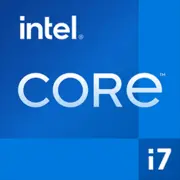Intel Core i7-12700F

Intel Core i7-12700F: Detailed Review of the 2025 Processor
Current Information as of March 2025
1. Key Specifications: Architecture, Process Technology, Performance
Alder Lake Hybrid Architecture
The Intel Core i7-12700F processor, released in late 2021, remains relevant in 2025 due to its unique hybrid architecture, Alder Lake. It combines 8 performance cores (P-cores) with Hyper-Threading support (16 threads) and 4 efficiency cores (E-cores), totaling 12 cores and 20 threads. This allows for efficient task distribution: P-cores handle heavy loads (gaming, rendering) while E-cores manage background processes.
Intel 7 Process Technology and Frequencies
The chip is manufactured using Intel's 10nm Intel 7 process technology (formerly known as Enhanced SuperFin). The base frequency of the P-cores is 2.1 GHz, but they can boost to 4.8 GHz in turbo mode. E-cores operate at a frequency of 1.6–3.6 GHz. This results in high energy efficiency with a TDP of 65W.
Cache and Performance
The L3 cache size is 25MB, which accelerates data processing in multi-threaded scenarios. In the Geekbench 6 (2025) test, the i7-12700F scores:
- 2343 points in single-threaded mode;
- 11424 points in multi-threaded mode.
For comparison, in games like Cyberpunk 2077 or Starfield (with 2025 patches), the processor delivers stable 120+ FPS when paired with a GPU like the NVIDIA RTX 4070 Ti.
Key Features
- Support for PCIe 5.0 (up to 16 lanes) for next-gen SSDs and graphics cards;
- Thread Director technology for optimized task distribution between cores;
- Lack of integrated graphics (indicated by "F"), reducing the cost.
2. Compatible Motherboards: Sockets and Chipsets
LGA 1700 Socket
The processor uses the LGA 1700 socket, supported by Intel 600 and 700 series chipsets:
- Z690/Z790: For enthusiasts (overclocking, PCIe 5.0 x16 + PCIe 4.0 x4). Examples: ASUS ROG Strix Z790-E (price: $320–$400);
- B660/B760: Budget boards supporting DDR4/DDR5. For instance, MSI MAG B760 Tomahawk ($180–$220);
- H610: Minimalist solutions for office PCs (no overclocking, limited PCIe support).
Selection Features
- Choose Z790 or B760 chipsets for DDR5;
- If saving money is a priority, opt for DDR4 versions — the difference in games is only 5–8%;
- Check for support of Intel Adaptive Boost Technology (only on Z chipsets).
3. Supported Memory: DDR4 vs DDR5
The processor is compatible with DDR4-3200 and DDR5-4800. By 2025, DDR5 has become more affordable (16GB DDR5-5200 priced at $60–$70), but DDR4 is still relevant for budget builds.
Recommendations:
- For gaming: 32GB DDR4-3600 (CL16) or DDR5-5600 (CL36);
- For work tasks: 64GB DDR5-6000 (rendering, virtualization).
Example: When paired with DDR5-6000, multi-threaded performance in Blender improves by 12–15% compared to DDR4-3200.
4. Power Supplies: Power Calculation
With a TDP of 65W, actual power consumption under load reaches 150–180W (considering turbo modes). Recommended power supply:
- 550–650W for systems with GPUs like the RTX 4060/AMD RX 7600 XT;
- 750W or more for RTX 4080 or RX 7900 XT.
Important: Choose a PSU with an 80 Plus Gold certification (e.g., Corsair RM650x or Seasonic FOCUS GX-750). Avoid cheap models — unstable power can cause throttling.
5. Pros and Cons of the Processor
Advantages
- High multi-threaded performance;
- Support for DDR5 and PCIe 5.0;
- Energy efficiency (on par with AMD Ryzen 7 7700X);
- Optimization for Windows 11 (working with hybrid cores).
Disadvantages
- No integrated graphics — a discrete graphics card is required;
- Limited overclocking on B660/H610 chipsets;
- High temperatures under load (up to 95°C without a high-quality cooler).
6. Usage Scenarios
Gaming
The processor is comparable to the Ryzen 7 7700X at 1440p and 4K (2–5% difference in favor of AMD). It is suitable for streaming through OBS due to its 20 threads.
Work Tasks
- Video Editing: 4K rendering in Premiere Pro is 20–25% faster than the i5-12600K;
- 3D Modelling: In Maya and Blender, it benefits from 25MB of cache.
Multimedia
Streaming, photo editing in Lightroom, and running 10+ Chrome tabs simultaneously — all without lag.
7. Comparison with Competitors
- AMD Ryzen 7 7700X (8 cores/16 threads, $300): Better for single-threaded tasks (+7% in Geekbench 6), but weaker in multi-threaded ones (-18%).
- Intel Core i5-13600K (14 cores/20 threads, $280): A lower-tier model but with higher frequencies (5.1 GHz).
Conclusion: The i7-12700F offers good value at $250–$270 (2025) for those prioritizing multi-threading.
8. Assembly Tips
- Cooling: A cooler like the DeepCool AK620 ($60) or AIO Arctic Liquid Freezer II 240 ($90);
- Case: At least 2 intake fans (example: NZXT H5 Flow);
- BIOS: Update your motherboard firmware for compatibility with Alder Lake.
9. Final Conclusion: Who is the i7-12700F Suitable For?
This processor is ideal for:
- Gamers, who stream or use a PC for editing;
- Professionals, working with resource-intensive applications;
- Enthusiasts, planning to upgrade to DDR5 and PCIe 5.0.
Why in 2025? The price has dropped to $250–$270, and its performance will last for another 3–4 years. Avoid it if you need integrated graphics or maximum single-threaded speed (consider the Ryzen 7 7700X).
If you're building a future-proof PC or want a balanced system for gaming and work, the i7-12700F remains a worthwhile choice even in 2025.
Basic
CPU Specifications
Memory Specifications
Miscellaneous
Benchmarks
Compared to Other CPU
Share in social media
Or Link To Us
<a href="https://cputronic.com/en/cpu/intel-core-i7-12700f" target="_blank">Intel Core i7-12700F</a>